The Relationship between Urban Functional Structure and Insomnia: An Exploratory Analysis in Beijing, China
Abstract
1. Introduction
2. Materials and Methods
2.1. Study Area and Data
2.1.1. Study Area
2.1.2. Data Source and Processing
2.2. Methods
2.2.1. Identification of Urban Functional Zones
2.2.2. Global Collaborative Location Quotient
2.2.3. Analysis of Impacts on Insomnia by Functional Facilities
3. Results
3.1. Distribution of Functional Zones in Beijing
3.2. Proximity Analysis between Insomnia Cases and Functional Zones
3.3. The Global Impacts of Functional Facilities on Insomnia
3.4. The Local Impacts of Functional Categories on Insomnia
4. Discussion
4.1. New Findings and Advantages
4.2. Planning Implications and Limitations
5. Conclusions
Author Contributions
Funding
Data Availability Statement
Acknowledgments
Conflicts of Interest
References
- Ghose, S.M.; Dzierzewski, J.M.; Dautovich, N.D. Sleep and self-efficacy: The role of domain specificity in predicting sleep health. Sleep Health 2023, 9, 190–195. [Google Scholar] [CrossRef] [PubMed]
- Li, C.; Ma, C.; Wu, H.; Zhao, M.; Zhu, D.; Xi, B. Sleep duration change from childhood to adulthood and adult depressive disorders in the Chinese population. Sleep Med. 2022, 100, 128–132. [Google Scholar] [CrossRef] [PubMed]
- Zhao, K.; Zhang, J.; Wu, Z.; Shen, X.; Tong, S.; Li, S. The relationship between insomnia symptoms and school performance among 4966 adolescents in Shanghai, China. Sleep Health 2019, 5, 273–279. [Google Scholar] [CrossRef] [PubMed]
- Rauchs, G.; Orban, P.; Schmidt, C.; Albouy, G.; Balteau, E.; Degueldre, C.; Schnackers, C.; Sterpenich, V.; Tinguely, G.; Luxen, A.; et al. Sleep modulates the neural substrates of both spatial and contextual memory consolidation. PLoS ONE 2008, 3, e2949. [Google Scholar] [CrossRef] [PubMed]
- Hein, M.; Lanquart, J.P.; Loas, G.; Hubain, P.; Linkowski, P. Objective sleep alterations and long-term use of short or intermediate half-life benzodiazepine receptor agonists are risk factors for high blood pressure in individuals with insomnia: A study in 1272 individuals referred for sleep examinations. Sleep Med. 2019, 53, 115–123. [Google Scholar] [CrossRef]
- Gilliland, J. Examining the impact of exposure to natural built environments on children’s sleep duration. Sleep Med. 2022, 100, S17. [Google Scholar] [CrossRef]
- Xu, X.; Lian, Z. Optimizing bedroom thermal environment: A review of human body temperature, sleeping thermal comfort and sleep quality. Energy Built Environ. 2024, 5, 829–839. [Google Scholar] [CrossRef]
- Gabinet, N.M.; Portnov, B.A. Investigating the combined effect of ALAN and noise on sleep by simultaneous real-time monitoring using low-cost smartphone devices. Environ. Res. 2022, 214 Pt 2, 113941. [Google Scholar] [CrossRef]
- Falch-Madsen, J.; Wichstrom, L.; Pallesen, S.; Ranum, B.M.; Steinsbekk, S. Child and family predictors of insomnia from early childhood to adolescence. Sleep Med. 2021, 87, 220–226. [Google Scholar] [CrossRef]
- Hsieh, Y.P.; Lu, W.H.; Yen, C.F. Psychosocial Determinants of Insomnia in Adolescents: Roles of Mental Health, Behavioral Health, and Social Environment. Front. Neurosci. 2019, 13, 848. [Google Scholar] [CrossRef]
- Nam, S.; Whittemore, R.; Jung, S.; Latkin, C.; Kershaw, T.; Redeker, N.S. Physical neighborhood and social environment, beliefs about sleep, sleep hygiene behaviors, and sleep quality among African Americans. Sleep Health 2018, 4, 258–264. [Google Scholar] [CrossRef] [PubMed]
- Wogan, R.; Enrique, A.; Adegoke, A.; Earley, C.; Sollesse, S.; Gale, S.; Chellingsworth, M.; Richards, D. Internet-delivered CBT intervention (Space for Sleep) for insomnia in a routine care setting: Results from an open pilot study. Internet Interv. 2021, 26, 100443. [Google Scholar] [CrossRef] [PubMed]
- Chaudhary, N.S.; Kampman, K.M.; Kranzler, H.R.; Grandner, M.A.; Debbarma, S.; Chakravorty, S. Insomnia in alcohol dependent subjects is associated with greater psychosocial problem severity. Addict. Behav. 2015, 50, 165–172. [Google Scholar] [CrossRef] [PubMed]
- Chaudhary, N.S.; Wong, M.M.; Kolla, B.P.; Kampman, K.M.; Chakravorty, S. The relationship between insomnia and the intensity of drinking in treatment-seeking individuals with alcohol dependence. Drug Alcohol Depend. 2020, 215, 108189. [Google Scholar] [CrossRef] [PubMed]
- Mayne, S.L.; Mitchell, J.A.; Virudachalam, S.; Fiks, A.G.; Williamson, A.A. Neighborhood environments and sleep among children and adolescents: A systematic review. Sleep Med. Rev. 2021, 57, 101465. [Google Scholar] [CrossRef]
- Sarzetto, A.; Bosia, M.; Pasqualoni, E.; Travaini, G. Eyes wide open: A systematic review of the association between insomnia and aggression in forensic contexts. Int. J. Law Psychiatry 2021, 78, 101734. [Google Scholar] [CrossRef]
- Spano, G.; D’Este, M.; Giannico, V.; Elia, M.; Cassibba, R.; Lafortezza, R.; Sanesi, G. Association between indoor-outdoor green features and psychological health during the COVID-19 lockdown in Italy: A cross-sectional nationwide study. Urban For. Urban Green. 2021, 62, 127156. [Google Scholar] [CrossRef]
- Bell, I.H.; Nicholas, J.; Broomhall, A.; Bailey, E.; Bendall, S.; Boland, A.; Robinson, J.; Adams, S.; McGorry, P.; Thompson, A. The impact of COVID-19 on youth mental health: A mixed methods survey. Psychiatry Res. 2023, 321, 115082. [Google Scholar] [CrossRef]
- Dyer, W.J.; Crandall, A.; Hanson, C.L. COVID-19 Stress, Religious Affiliation, and Mental Health Outcomes Among Adolescents. J. Adolesc. Health 2023, 72, 892–898. [Google Scholar] [CrossRef]
- Johnson, B.S.; Malecki, K.M.; Peppard, P.E.; Beyer, K.M. Exposure to neighborhood green space and sleep: Evidence from the Survey of the Health of Wisconsin. Sleep Health 2018, 4, 413–419. [Google Scholar] [CrossRef]
- Wang, T.; Li, J.; Wang, Y.; Dai, S.; Shao, R.; Hao, L. Active interventions of dynamic lighting on human circadian rhythm and sleep quality in confined spaces. Build. Environ. 2022, 226, 109766. [Google Scholar] [CrossRef]
- Xie, Y.; Xiang, H.; Di, N.; Mao, Z.; Hou, J.; Liu, X.; Huo, W.; Yang, B.; Dong, G.; Wang, C.; et al. Association between residential greenness and sleep quality in Chinese rural population. Environ. Int. 2020, 145, 106100. [Google Scholar] [CrossRef] [PubMed]
- Lin, J.; Kong, Y.; Zhong, L. Optimization of environment control system for narrow sleeping space in underground shelters. Energy Build. 2022, 263, 112043. [Google Scholar] [CrossRef]
- Baek, S.-U.; Yoon, J.-H.; Won, J.-U. Mediating Effect of Work–Family Conflict on the Relationship Between Long Commuting Time and Workers’ Anxiety and Insomnia. Saf. Health Work 2023, 14, 100–106. [Google Scholar] [CrossRef] [PubMed]
- Liu, Y.; Luo, Q.; Shen, H.; Zhuang, S.; Xu, C.; Dong, Y.; Sun, Y.; Wang, S.; Deng, H. Social Media Big Data-Based Research on the Influencing Factors of Insomnia and Spatiotemporal Evolution. IEEE Access 2020, 8, 41516–41529. [Google Scholar] [CrossRef]
- Wu, C.; Ye, X.; Ren, F.; Du, Q. Check-in behaviour and spatio-temporal vibrancy: An exploratory analysis in Shenzhen, China. Cities 2018, 77, 104–116. [Google Scholar] [CrossRef]
- Wang, C.; Zhan, J.; Wang, H.; Yang, Z.; Chu, X.; Liu, W.; Teng, Y.; Liu, H.; Wang, Y. Multi-group analysis on the mechanism of residents’ low-carbon behaviors in Beijing, China. Technol. Forecast. Social. Chang. 2022, 183, 121956. [Google Scholar] [CrossRef]
- Sato, S.; Liu, Y.; Ikeda, A.; Filomeno, R.; Suzuki, Y.; Maruyama, K.; Tomooka, K.; Wada, H.; Koyama, Y.; Tanigawa, T. Work-family conflict and insomnia symptoms among women working in aged care services in Japan. Sleep Med. 2021, 82, 155–158. [Google Scholar] [CrossRef]
- Alfred, R.; Chen, Z.; Eboy, O.V.; Luxuan, Z.; Renjie, L. Analyzing trends in the spatial-temporal visitation patterns of mainland Chinese tourists in Sabah, Malaysia based on Weibo social big data. Heliyon 2023, 9, e15526. [Google Scholar] [CrossRef]
- Gan, M.; Ma, Y. Mapping user interest into hyper-spherical space: A novel POI recommendation method. Inf. Process. Manag. 2023, 60, 103169. [Google Scholar] [CrossRef]
- Ma, C.-X.; Peng, F.-L. Evaluation of spatial performance and supply-demand ratios of urban underground space based on POI data: A case study of Shanghai. Tunn. Undergr. Space Technol. 2023, 131, 104775. [Google Scholar] [CrossRef]
- Tian, X.; Yu, G.; He, F. An analysis of sleep complaints on Sina Weibo. Comput. Hum. Behav. 2016, 62, 230–235. [Google Scholar] [CrossRef]
- Kumakoshi, Y.; Koizumi, H.; Yoshimura, Y. Diversity and density of urban functions in station areas. Comput. Environ. Urban Syst. 2021, 89, 101679. [Google Scholar] [CrossRef]
- Wei, C.; Meng, J.; Zhu, L.; Han, Z. Assessing progress towards sustainable development goals for Chinese urban land use: A new cloud model approach. J. Environ. Manag. 2023, 326 Pt B, 116826. [Google Scholar] [CrossRef] [PubMed]
- Zhu, L. Analysis and Research on the Change of Urban functional zone Based on POI Data. Geomat. Spat. Inf. Technol. 2024, 47, 186–189. [Google Scholar] [CrossRef]
- Leslie, T.F.; Kronenfeld, B.J. The Colocation Quotient: A New Measure of Spatial Association Between Categorical Subsets of Points. Geogr. Anal. 2011, 43, 306–326. [Google Scholar] [CrossRef]
- Carvalho, C.; Nechio, F.; Tristão, T. Taylor rule estimation by OLS. J. Monet. Econ. 2021, 124, 140–154. [Google Scholar] [CrossRef]
- He, Q.; Zhang, Y. Residential locations and residential moves between the city centre and suburb in Beijing, China. Habitat Int. 2023, 131, 102711. [Google Scholar] [CrossRef]
- Labaran, R.S.; Johnson, S.; Johnson, D.A. The association of stress and work hours with sleep duration and insomnia symptoms among U.S.-born and Foreign-born Black adults. Sleep Health 2023, 9, 56–63. [Google Scholar] [CrossRef]
- Dong, Y.-H.; Peng, F.-L.; Li, H.; Men, Y.-Q. Spatial autocorrelation and spatial heterogeneity of underground parking space development in Chinese megacities based on multisource open data. Appl. Geogr. 2023, 153, 102897. [Google Scholar] [CrossRef]
- Kayaba, M.; Ihara, T.; Kusaka, H.; Iizuka, S.; Miyamoto, K.; Honda, Y. Association between sleep and residential environments in the summertime in Japan. Sleep Med. 2014, 15, 556–564. [Google Scholar] [CrossRef] [PubMed]
- Perez-Crespo, L.; Essers, E.; Foraster, M.; Ambros, A.; Tiemeier, H.; Guxens, M. Outdoor residential noise exposure and sleep in preadolescents from two European birth cohorts. Environ. Res. 2023, 225, 115502. [Google Scholar] [CrossRef] [PubMed]
- Ju, Y.J.; Lee, J.E.; Choi, D.W.; Han, K.T.; Lee, S.Y. Association between perceived environmental pollution and poor sleep quality: Results from nationwide general population sample of 162,797 people. Sleep Med. 2021, 80, 236–243. [Google Scholar] [CrossRef] [PubMed]
- Liu, F.; Zhou, F.; Zhang, K.; Wu, T.; Pan, M.; Wang, X.; Tong, J.; Chen, Z.; Xiang, H. Effects of air pollution and residential greenness on sleep disorder: A 8-year nationwide cohort study. Environ. Res. 2023, 220, 115177. [Google Scholar] [CrossRef] [PubMed]
- Kallawicha, K.; Boonvisut, S.; Chao, H.J.; Nitmetawong, T. Bedroom environment and sleep quality of apartment building residents in urban Bangkok. Build. Environ. 2020, 188, 107474. [Google Scholar] [CrossRef]
- Zhou, N. Research on urban spatial structure based on the dual constraints of geographic environment and POI big data. J. King Saud Univ. Sci. 2022, 34, 101887. [Google Scholar] [CrossRef]
- Liu, Y.; Wang, X.; Sun, P.; Zhang, Q.; Zhang, C.; Shen, Y.; Wang, S.; Ma, J.; Wang, G. Sleep disturbance and anxiety symptom among public during the second wave of COVID-19 in Beijing: A web-based cross-sectional survey. J. Affect. Disord. 2022, 298 Pt A, 80–85. [Google Scholar] [CrossRef]
- Wang, K.; Yuan, Y.; Chen, M.; Wang, D. A POIs based method for determining spatial distribution of urban fire risk. Process Saf. Environ. Prot. 2021, 154, 447–457. [Google Scholar] [CrossRef]
- Zhu, C.; Zhang, X.; Zhou, M.; He, S.; Gan, M.; Yang, L.; Wang, K. Impacts of urbanization and landscape pattern on habitat quality using OLS and GWR models in Hangzhou, China. Ecol. Indic. 2020, 117, 106654. [Google Scholar] [CrossRef]
- Huang, R.; Wu, W.; Yu, K. Building consistent time series night-time light data from average DMSP/OLS images for indicating human activities in a large-scale oceanic area. Int. J. Appl. Earth Obs. Geoinf. 2022, 114, 103023. [Google Scholar] [CrossRef]
- Chan, N.Y.; Li, S.X.; Zhang, J.; Lam, S.P.; Yu, M.M.W.; Kwok, P.L.; Li, A.M.; Morin, C.M.; Wing, Y.K. Can we prevent insomnia?A brief cognitive behavioral therapy in at-risk adolescents. Sleep Med. 2019, 64, S61. [Google Scholar] [CrossRef]
- Cronlein, T.; Wetter, T.C.; Rupprecht, R.; Spiegelhalder, K. Cognitive behavioral treatment for insomnia is equally effective in insomnia patients with objective short and normal sleep duration. Sleep Med. 2020, 66, 271–275. [Google Scholar] [CrossRef] [PubMed]
- Büttner-Teleaga, A.D. Migration, mental health and sleep. Sleep Med. 2022, 100, S49–S50. [Google Scholar] [CrossRef]
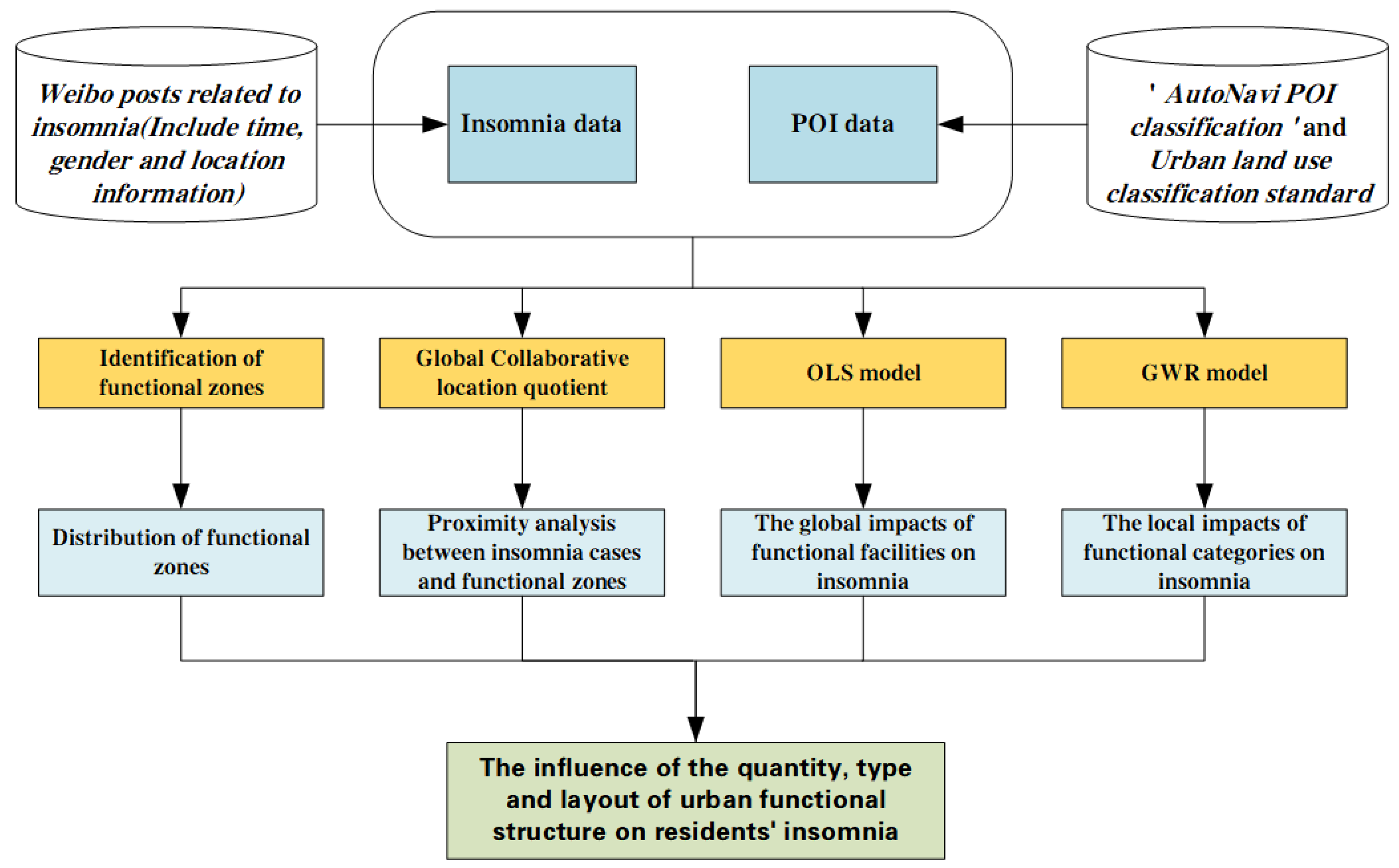
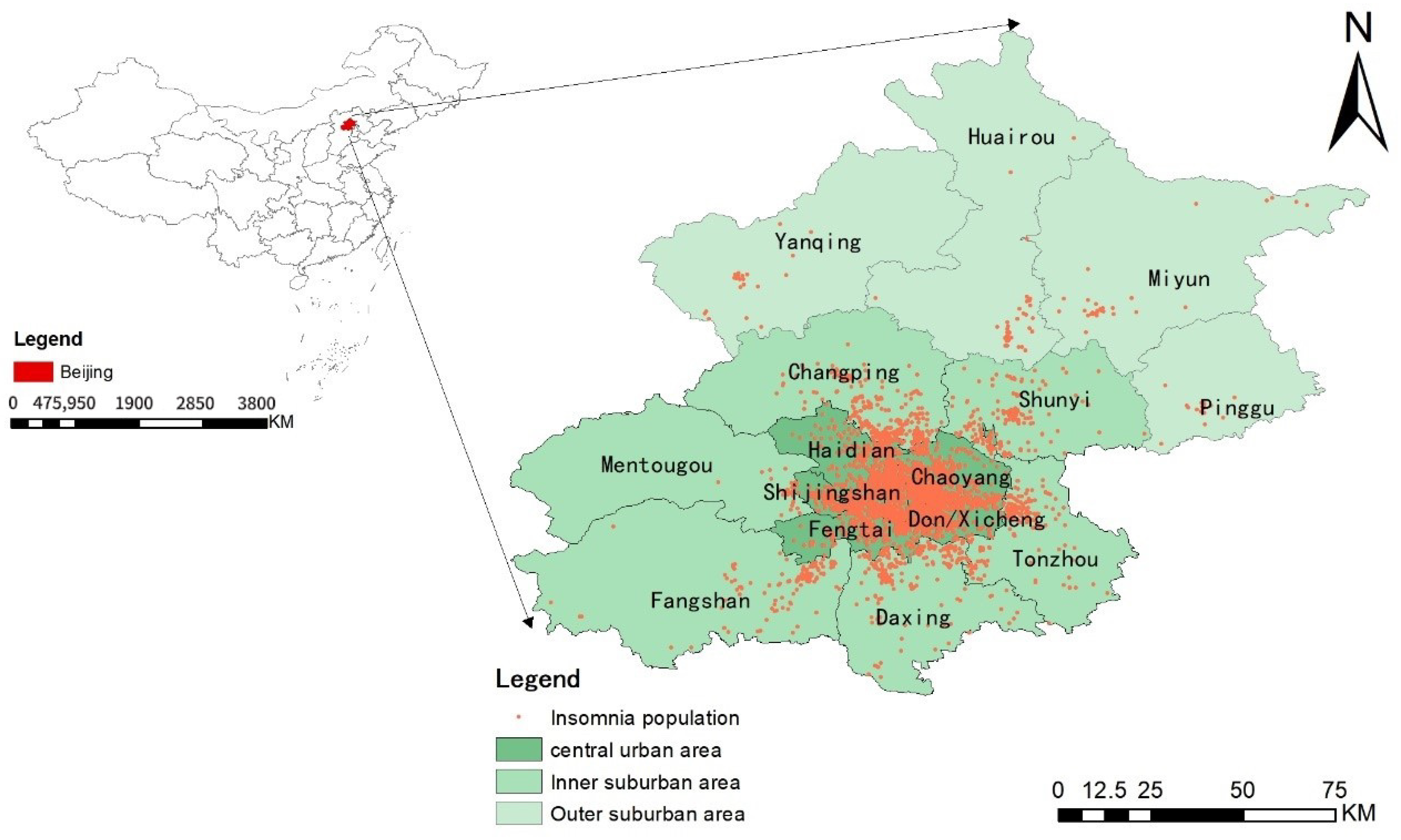
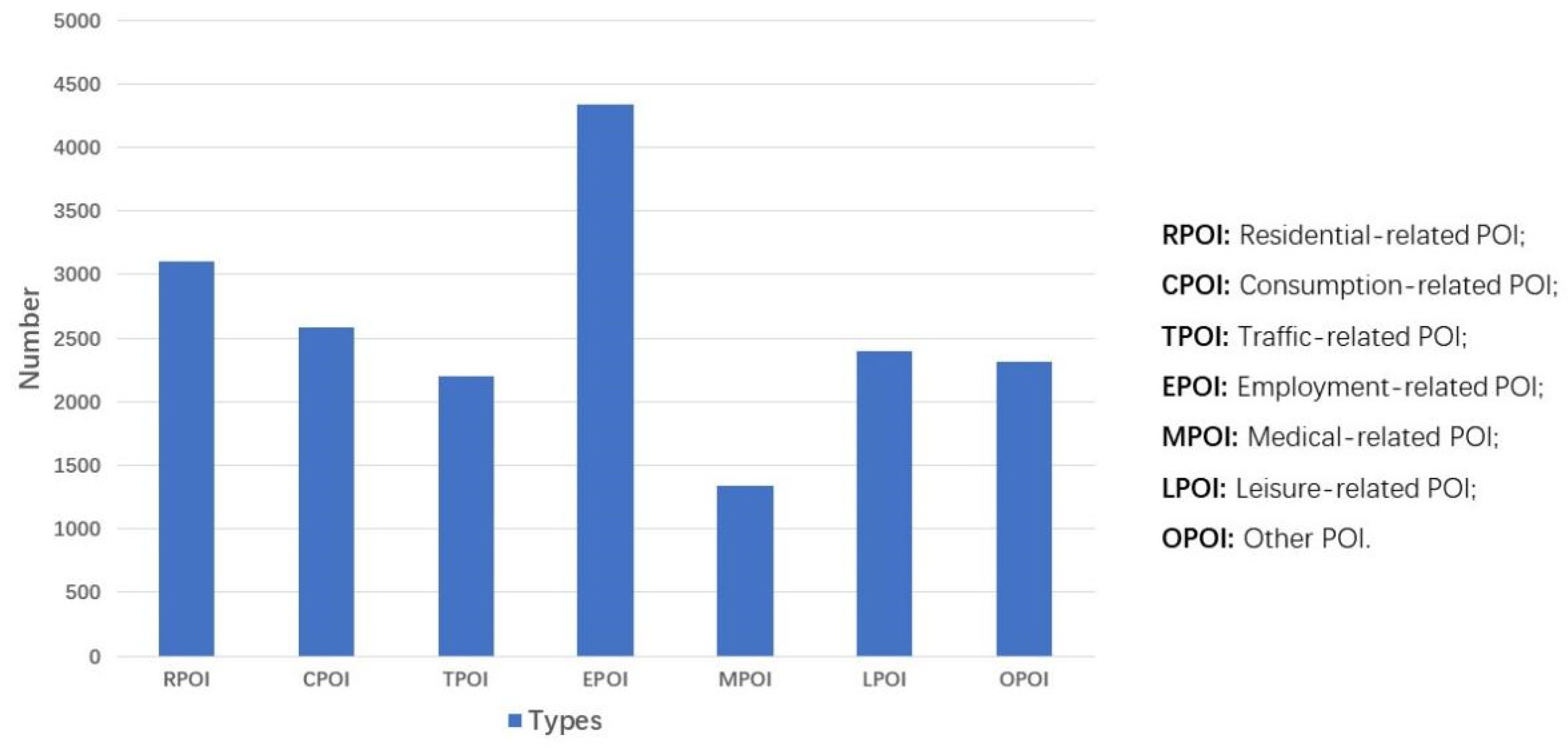
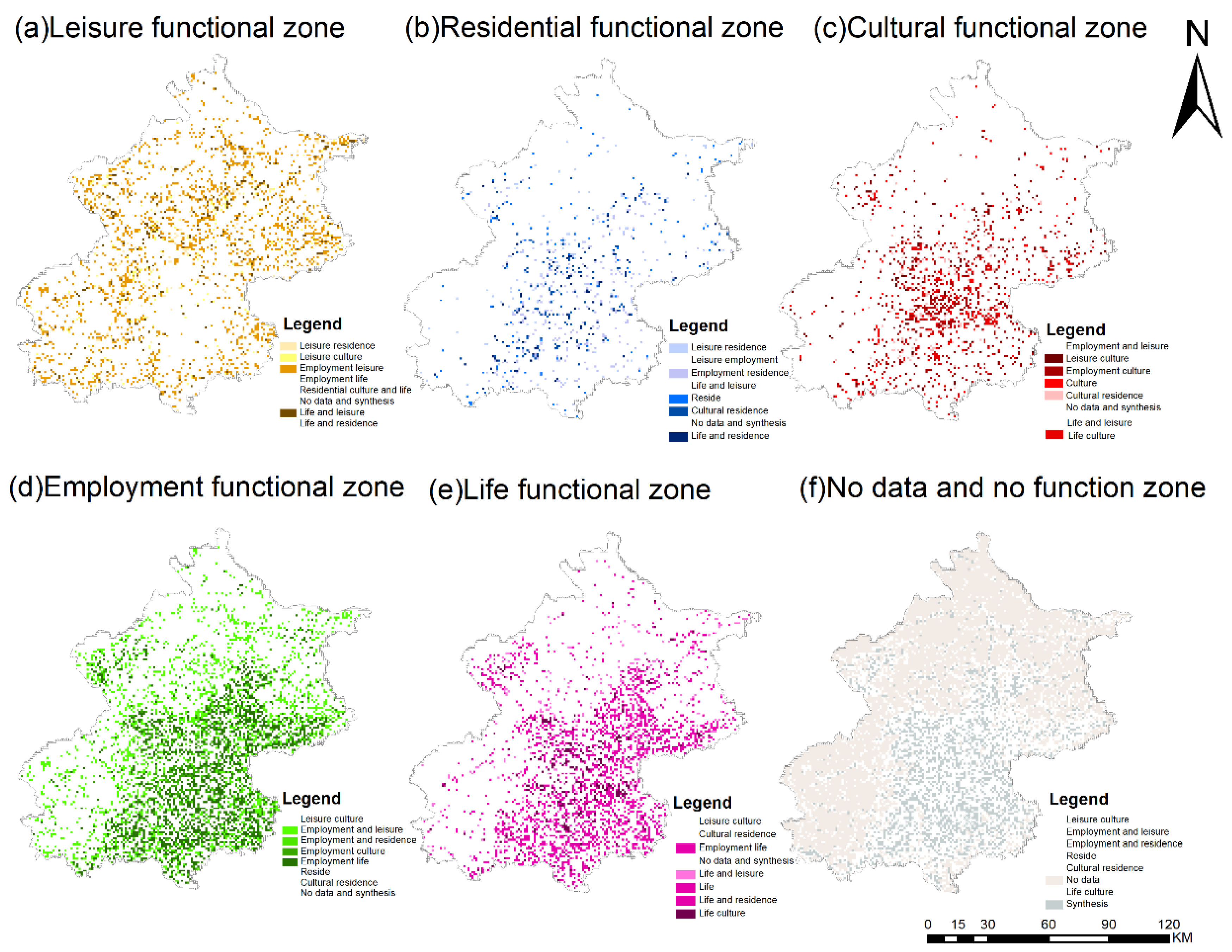


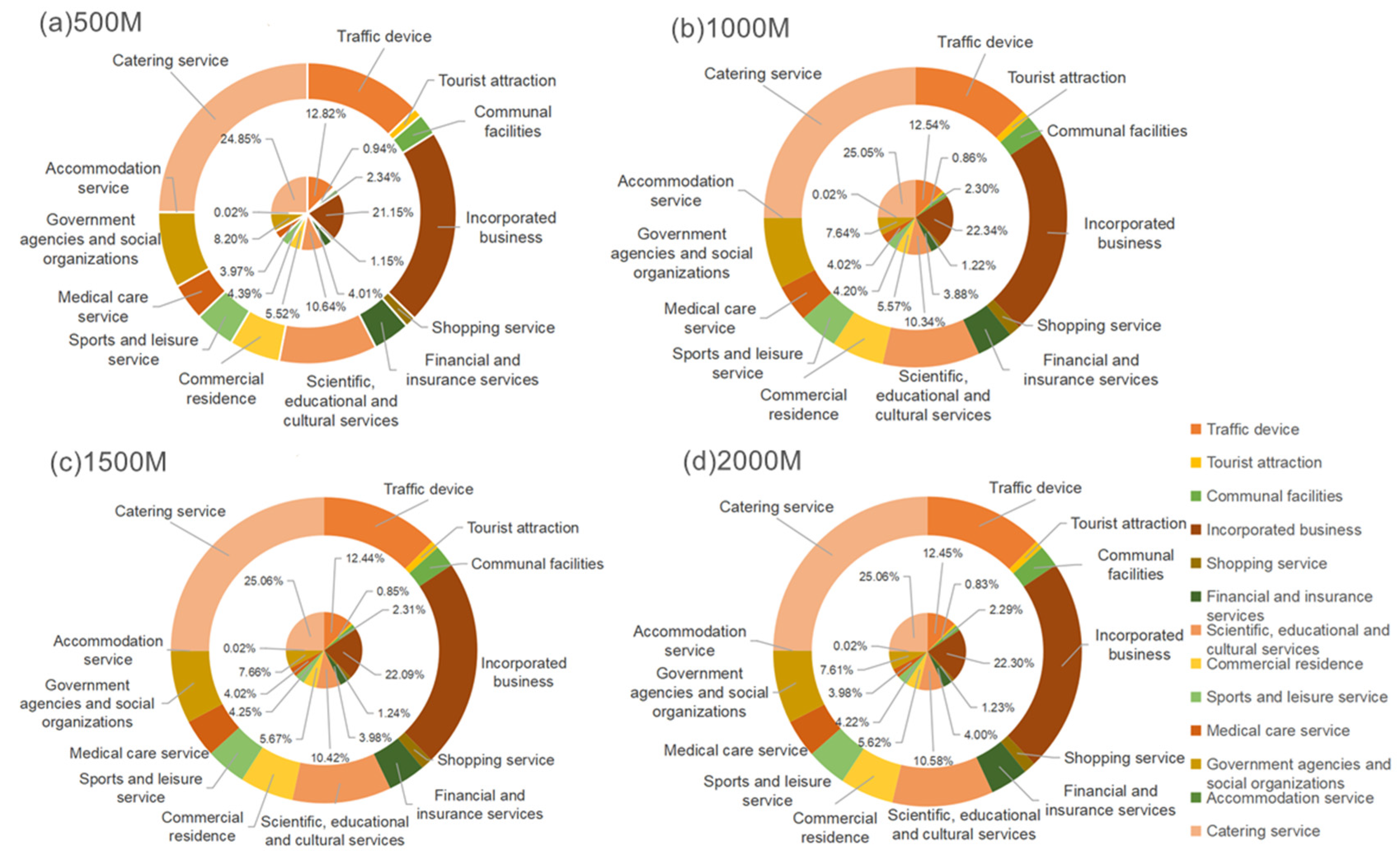
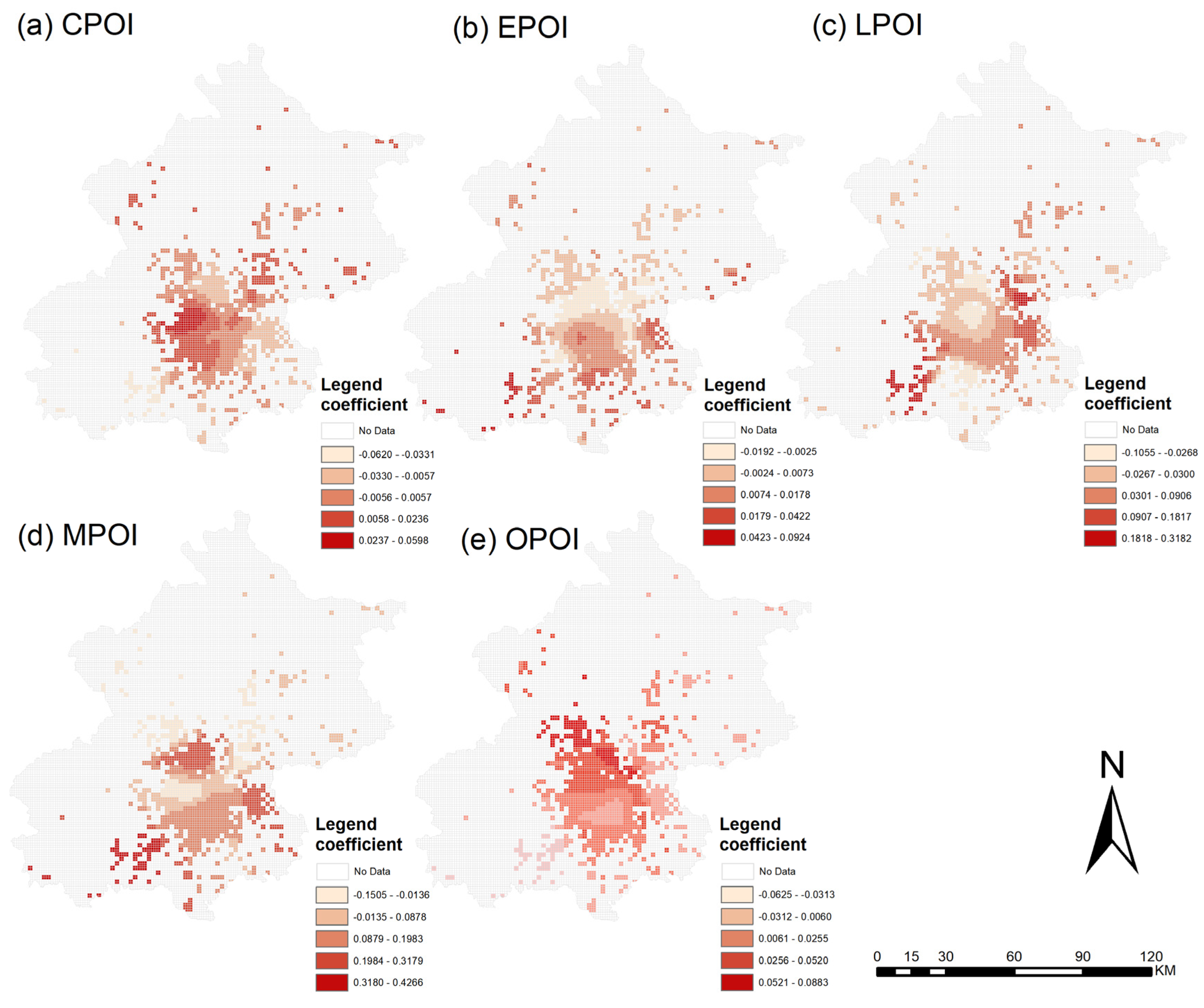
| 500 m | 1000 m | 1500 m | 2000 m | |
|---|---|---|---|---|
| TD | 0.177 *** | 0.031 *** | 0.016 *** | 0.010 *** |
| TA | 0.088 | 0.010 | −0.004 | −0.019 * |
| CF | 0.206 ** | −0.004 | −0.006 | −0.004 |
| IB | 0.001 | 0.004 | 0.001 | 0.000 |
| SS | −0.479 ** | 0.021 | 0.048 | 0.035 |
| F&IS | −0.019 | −0.042 * | −0.032 *** | −0.024 *** |
| SE&CS | 0.071 ** | 0.033 *** | 0.019 *** | 0.012 *** |
| CR | 0.152 ** | 0.077 *** | 0.026 ** | 0.015 ** |
| S&LS | 0.072 | 0.059 * | 0.035 *** | 0.025 *** |
| MCS | 0.165 ** | 0.061 ** | 0.048 *** | 0.026 ** |
| GA&SO | −0.007 | −0.020 ** | −0.014 | −0.006 |
| AS | 2.617 | −0.742 | −0.386 | 0.025 |
| CS | −0.018 | −0.002 | 0.000 | 0.000 |
| R2 | 0.575 | 0.704 | 0.760 | 0.767 |
Disclaimer/Publisher’s Note: The statements, opinions and data contained in all publications are solely those of the individual author(s) and contributor(s) and not of MDPI and/or the editor(s). MDPI and/or the editor(s) disclaim responsibility for any injury to people or property resulting from any ideas, methods, instructions or products referred to in the content. |
© 2024 by the authors. Licensee MDPI, Basel, Switzerland. This article is an open access article distributed under the terms and conditions of the Creative Commons Attribution (CC BY) license (https://creativecommons.org/licenses/by/4.0/).
Share and Cite
Chen, S.; Xing, L.; Liu, Y.; Xu, J. The Relationship between Urban Functional Structure and Insomnia: An Exploratory Analysis in Beijing, China. Urban Sci. 2024, 8, 137. https://doi.org/10.3390/urbansci8030137
Chen S, Xing L, Liu Y, Xu J. The Relationship between Urban Functional Structure and Insomnia: An Exploratory Analysis in Beijing, China. Urban Science. 2024; 8(3):137. https://doi.org/10.3390/urbansci8030137
Chicago/Turabian StyleChen, Sirui, Lijun Xing, Yu Liu, and Jiwei Xu. 2024. "The Relationship between Urban Functional Structure and Insomnia: An Exploratory Analysis in Beijing, China" Urban Science 8, no. 3: 137. https://doi.org/10.3390/urbansci8030137
APA StyleChen, S., Xing, L., Liu, Y., & Xu, J. (2024). The Relationship between Urban Functional Structure and Insomnia: An Exploratory Analysis in Beijing, China. Urban Science, 8(3), 137. https://doi.org/10.3390/urbansci8030137






